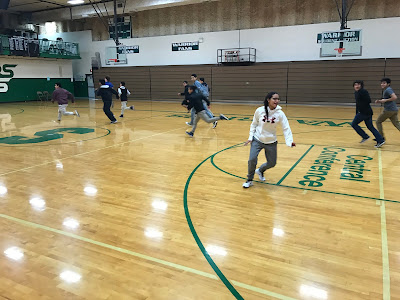It was a great Desmos activity, almost all the students wanted 100$ at the beginning and very insightful finishing questions at the end and I was pleased overall. Later that day I began to wonder if students would notice if something was exponential or not exponential if I gave it to them. I thought to myself how could I find a question that I could do that would model exponential growth or decay.
Then I found this game:
I wanted an activity that got students out of the classroom. Since I have two periods at the beginning of the day we did inside in the gym, but the last time we went outside and played it on the Football field.
If you didn't watch the video, it is a simple game where one person is a shark, they yell "Minnows come out to play." the minnows job is to make it to the other side without getting tagged. The sharks job is to tag people, once a minnow is tagged they become a shark.
Here comes the math:
I had them start out with one shark, I made all the others line up and asked them how easy it was going to be this time down. All of them were confident that they could make it down without any real sweat, then I asked them what about the 5th time down? I was surprised how most of them thought it was still going to be easy, thinking of it linearly instead of exponential. We played it through the first time here are the pictures and the charts we did at the end.
Here is one of the charts that I made after each run down and back.
After all the students were tagged on the 4th down and back with ease. I asked them to estimate how many would get tagged on the fourth time back. Then I asked about the whole school, how many down and backs would there be playing with 576 students?
We came back after playing 2-3 more times. Then asked them how you could write an equation to model the graph. We did a short mini-lesson on finding equations of a exponential graph.









